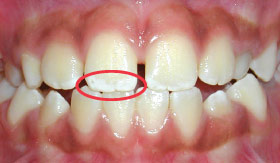Tooth Development And Infant Formula
Monitoring Fluoride In Your Child's First Year
Dear Doctor,
I mix my four-month-old baby's powdered formula with our tap water, which I think is fluoridated. Is this okay?

Dear Sue,
Good question. While it's important for your baby to get enough fluoride for strong tooth development and decay prevention, too much of this important mineral can lead to a condition called “enamel fluorosis.” This can cause a mottled or streaked appearance of your child's permanent (adult) teeth. In mild cases, the streaks or patches are white in color and may be barely noticeable. In more severe cases, a darker stain with a pitted texture can be evident. It is a cosmetic problem and not a sign of disease, but the staining is permanent and may eventually require cosmetic treatment in severe cases.
How does fluorosis occur? As both deciduous (baby) and permanent teeth are developing in the jaws, fluoride from water and the diet becomes incorporated into the tooth structure. This helps the teeth become strong and more resistant to decay. Infants and toddlers are exposed to fluoride in various ways — mostly from the liquids they drink. Many parents like you feed their babies powdered formula reconstituted with drinking water. Fluoride is naturally present in water to various degrees, and most municipal water systems add it to the water supply to promote good dental health.
Bottled water, juice and other beverages may also contain fluoride — in varying amounts. The trouble is, it's hard to know how much; there is no labeling requirement unless the fluoride has been specifically added. And fluoride intake is cumulative. Finally, many dental products such as toothpaste contain fluoride and very young children tend to swallow toothpaste rather than spit it out. That's why the American Academy of Pediatric Dentistry recommends just a small “smear” of fluoridated toothpaste for children under 2, and that children 2-6 use only a pea-sized amount when brushing, and no more than twice a day.
Fluoride use is mainly a concern up until the age of about 9, when the enamel of the permanent teeth has developed. You might be tempted to leave out fluoride entirely early on. That would be a big mistake. Tooth decay is the most common chronic disease of childhood and can cause far more serious health problems than enamel fluorosis, which tends to be mild if it happens at all. That's why approximately 72% of all public water systems, serving about 195 million people in the US, add fluoride to the level recommended to prevent tooth decay. This recommendation has recently been revised to 0.70 ppm (parts per million).
 |
| The stark white areas of enamel represent a small area of enamel fluorosis, which develops if your child is getting too much fluoride. |
So how do you know if your baby is getting too much? You are right to zero in on drinking water, because that is the most likely source of fluoride in the case of a formula-fed infant (human breast milk has little fluoride). The formula powder itself probably does not contain very much. But it's important for you to find out exactly how much fluoride your drinking water contains.
A good place to start is your local water utility or health department. If your state participates in the federal Centers for Disease Control and Prevention (CDC) program known as “My Water's Fluoride,” you may be able to look up your water's fluoride content online. Go to //www//apps.nccd.cdc.gov/MWF/Index.asp to see if your community is listed. A local pediatric dentist or your child's pediatrician should also be able to help you with this issue.
In areas where fluorosis has been identified as a risk, experts recommend the following:
- Breast-feeding
- Using ready-to-feed formula, which contains lower levels of fluoride
- Mixing powdered formula with bottled water specifically labeled as “de-ionized,” “purified,” “demineralized,” or “distilled.”
I realize none of these choices offers the ease and/or economy of powdered formula, which is why you should seek the help of local health and dental professionals to come up with a plan that's best for you and your child.




